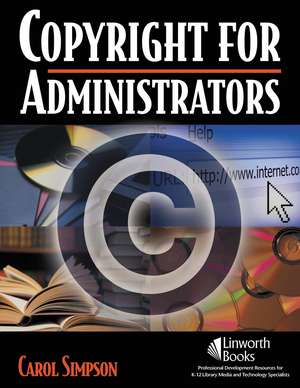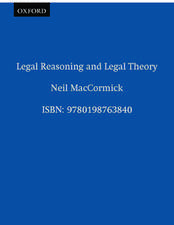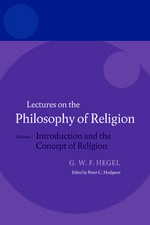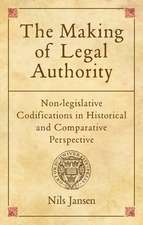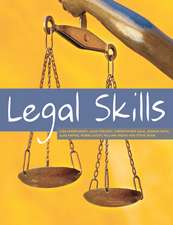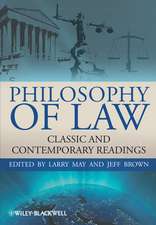Copyright for Administrators: Copyright Series
Autor Carol Simpson Editat de Christine Weiseren Limba Engleză Paperback – 9 iun 2008 – vârsta până la 17 ani
Preț: 221.36 lei
Preț vechi: 287.12 lei
-23% Nou
Puncte Express: 332
Preț estimativ în valută:
42.37€ • 46.04$ • 35.61£
42.37€ • 46.04$ • 35.61£
Carte tipărită la comandă
Livrare economică 21 aprilie-05 mai
Preluare comenzi: 021 569.72.76
Specificații
ISBN-13: 9781586833237
ISBN-10: 1586833235
Pagini: 128
Dimensiuni: 152 x 229 x 5 mm
Greutate: 0.2 kg
Editura: Bloomsbury Publishing
Colecția Linworth
Seria Copyright Series
Locul publicării:New York, United States
ISBN-10: 1586833235
Pagini: 128
Dimensiuni: 152 x 229 x 5 mm
Greutate: 0.2 kg
Editura: Bloomsbury Publishing
Colecția Linworth
Seria Copyright Series
Locul publicării:New York, United States
Notă biografică
Carol Simpson, JD, EdD, is associate professor in the College of Information, Library Science and Technologies of the University of North Texas, and practices school law. Christine Weiser has been reporting on the education industry for over fifteen years.
Recenzii
Carol Simpson's expertise in education and law is evident in this comprehensive and clearly written guide to educational copyright issues. Following opening chapters on the law, public domain, and fair use, succeeding chapters give full coverage to applying copyright to print and non-print material use in schools. Many practical examples clarify what is and is not acceptable use of materials. A sample copyright policy, copyright warning notices, and guidelines for student are some of the useful documents included. This book is a must for every librarian, principal, and curriculum leader.
School administrators who are struggling with understanding copyright as it pertains to the various types of media now available need to look no further than this informative volume. In clear, concise text, Simpson covers all aspects of copyright law. The chapters on computer software, Internet, and digital media are particularly informative as there is very little copyright information available for these formats. Simpson answers questions that teachers, principals and other staff are asking about topics, such as public perfomance rights for audio visual materials and what print materials they can and cannot copy. She points out that it is essential for school administrators to be aware of copyright law, as it could end up costing them not only thousands of dollars, but hours of time in court as well. Simpson deftly handles this complex topic, making it easy for readers to quickly find the information they need rather paging through chapter after chapter of unneeded text. To further aid readers, a variety of appendixes with useful tools, such as a sample copyright policy and a list of important Internet links for copyright information are included. Simpson finishes up with a glossary that even a copyright novices will have no trouble using.
The vast majority of educators seem to believe that since they are using material for educational purposes, they are completely protected through fair use exemptions. This well-organized and timely manual seeks to clarify this misconception. In this day of increasing intellectual ownership vigilance, teachers and administrative staff need as much help as possible to navigate copyright legislation. Carol Simpson stresses that the information she provides is no substitute for qualified legal advice. She presents a solid overview that summarizes issues, offers clarifications, and indicates when it might be advisable to consult an attorney. Chapters cover definitions and legislation, public domain materials, and fair use. Print materials in schools (including thorny issues such as photocopying), audio visual materials (including public performance guidelines), music materials (both reproduction and performance considerations), multimedia, distance learning, the Internet, and software are considered. There is a chapter on copyright policies and their implementation. The final section consists of reproducible forms and a bibliography of online resources. This accessible guide is straightforward and user-friendly, employing bulleted lists and highlighted summaries, and will help media specialists interpret fair use and provide administrators with the necessary background to understand its implications. Index. Recommended.
School administrators who are struggling with understanding copyright as it pertains to the various types of media now available need to look no further than this informative volume. In clear, concise text, Simpson covers all aspects of copyright law. The chapters on computer software, Internet, and digital media are particularly informative as there is very little copyright information available for these formats. Simpson answers questions that teachers, principals and other staff are asking about topics, such as public perfomance rights for audio visual materials and what print materials they can and cannot copy. She points out that it is essential for school administrators to be aware of copyright law, as it could end up costing them not only thousands of dollars, but hours of time in court as well. Simpson deftly handles this complex topic, making it easy for readers to quickly find the information they need rather paging through chapter after chapter of unneeded text. To further aid readers, a variety of appendixes with useful tools, such as a sample copyright policy and a list of important Internet links for copyright information are included. Simpson finishes up with a glossary that even a copyright novices will have no trouble using.
The vast majority of educators seem to believe that since they are using material for educational purposes, they are completely protected through fair use exemptions. This well-organized and timely manual seeks to clarify this misconception. In this day of increasing intellectual ownership vigilance, teachers and administrative staff need as much help as possible to navigate copyright legislation. Carol Simpson stresses that the information she provides is no substitute for qualified legal advice. She presents a solid overview that summarizes issues, offers clarifications, and indicates when it might be advisable to consult an attorney. Chapters cover definitions and legislation, public domain materials, and fair use. Print materials in schools (including thorny issues such as photocopying), audio visual materials (including public performance guidelines), music materials (both reproduction and performance considerations), multimedia, distance learning, the Internet, and software are considered. There is a chapter on copyright policies and their implementation. The final section consists of reproducible forms and a bibliography of online resources. This accessible guide is straightforward and user-friendly, employing bulleted lists and highlighted summaries, and will help media specialists interpret fair use and provide administrators with the necessary background to understand its implications. Index. Recommended.
